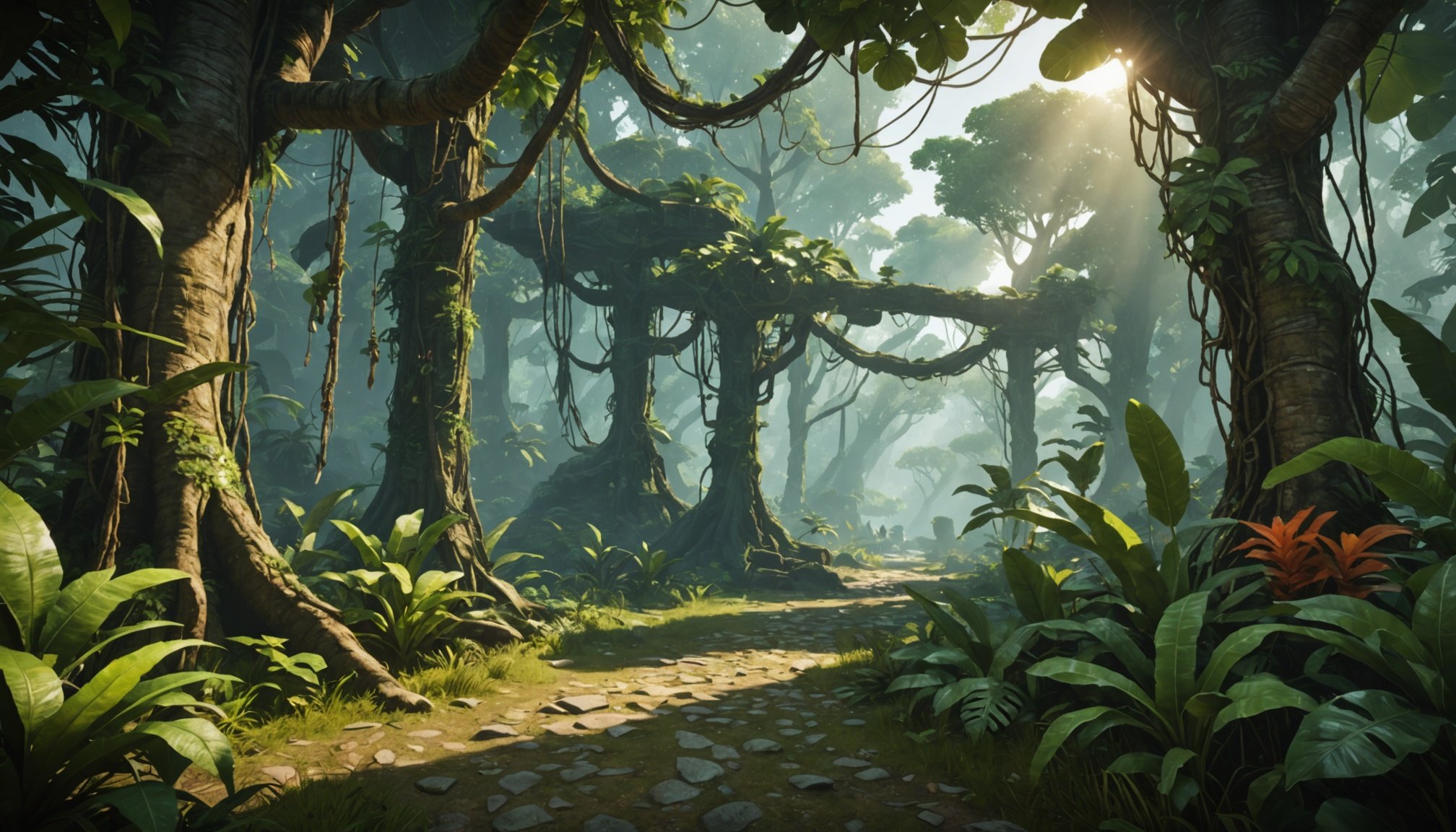Unlocking the Secrets of Dynamic Jungle Foliage for Immersive Adventure Games: Essential Techniques Uncovered
Creating an immersive and realistic jungle environment in adventure games is a complex but rewarding task. It involves a blend of artistic vision, technical prowess, and a deep understanding of how to make virtual foliage feel alive and interactive. Here, we’ll delve into the essential techniques that game developers use to craft dynamic and engaging jungle foliage, enhancing the gaming experience for players.
The Importance of Realistic Foliage in Game Environments
In the world of video games, especially in open-world and role-playing games like “The Witcher 3” and “Red Dead Redemption 2,” foliage plays a crucial role in creating an immersive environment. Realistic foliage is not just about visuals; it’s about crafting an experience that makes players feel like they are part of the game world.
Also read : Mastering the Game: Essential Strategies for Seamless Transitions Between VR and Classic Gaming Modes
“Foliage, with its subtle rustling and varied textures, plays a crucial role in this. When foliage is designed to mimic real-life vegetation, it enriches the player’s experience, making virtual worlds feel authentic,” explains a game developer from DoubleJump Academy[2].
Techniques for Designing Lifelike Foliage
Using High-Quality Textures and Reference Photos
One of the foundational techniques for creating lifelike foliage is the use of high-quality textures derived from reference photos. These textures provide a basis for creating detailed and realistic foliage that mirrors natural elements.
In the same genre : Unleash Endless Journeys: Transforming RPG Adventures Through AI-Powered Procedural Generation
“Through careful study of natural environments, designers can ensure that their virtual foliage mirrors real-world counterparts,” notes an article on foliage design techniques[1].
Here are some key steps to create these textures:
- Collect Reference Photos: Gather photos of different plants in various climates to study their textures, shapes, and colors.
- Create Detailed Textures: Use software like Substance Painter to create high-quality textures that capture the intricate details of leaves and branches.
- Apply Screen-Space UVs and Tri-planer Projection: These techniques help in creating realistic and varied textures that adapt to different angles and lighting conditions[2].
Shaping Foliage for Realism
The shape of foliage is another critical aspect of achieving realism. By observing different plants, designers can replicate the intricate structures of leaves and branches.
“By observing different plants in various climates, designers can replicate the intricate structures of leaves and branches, adding depth and authenticity to virtual landscapes,” explains the article on foliage design techniques[1].
Here’s a step-by-step guide to shaping foliage:
- Basic Shapes: Start with basic shapes using 3D software.
- Detailing: Progressively detail the shapes with branch and leaf patterns.
- Refine Details: Adjust each layer with varying opacities to achieve a realistic look.
Lighting and Shadows
Lighting and shadows are essential for making foliage feel immersive. Realistic foliage becomes even more engaging when light sources interact dynamically with the shapes and textures, casting natural shadows that change with environmental conditions.
“Realistic foliage becomes even more immersive when light sources interact dynamically with the shapes and textures, casting natural shadows that change with environmental conditions,” notes the article[1].
Advanced Simulation Tools and Techniques
Procedural Mesh Generation and Dynamic Simulations
Using advanced simulation tools like Houdini and Unreal Engine can significantly enhance the realism of foliage. These tools allow for procedural mesh generation and dynamic simulations that make foliage react to environmental factors like wind, rain, and player interactions.
“Houdini’s fracturing and destruction workflows are incredibly powerful for creating game-ready procedural art assets. You can create procedural meshes in seconds that would take hours to create and place by hand,” explains Grayson Cotrell, a Dynamics Technical Artist at Naughty Dog[2].
Here are some key techniques to consider:
- Procedural Mesh Generation: Use tools like Houdini to generate detailed models of trees, bushes, and other foliage.
- Dynamic Simulations: Employ dynamic simulations to make foliage react realistically to wind, rain, and player interactions.
- Material and Texture Creation: Utilize tools like Substance Painter to create high-quality materials and textures that make foliage look real and detailed.
Optimization Techniques for Smooth Gameplay
Creating stunning foliage isn’t just about aesthetics; it’s also about ensuring that the game runs smoothly. Here are some optimization techniques that game developers use:
Level of Detail (LOD) Systems
Using different levels of detail for foliage based on distance from the player is a common optimization technique.
“Level of Detail (LOD) systems reduce the computational load while maintaining visual quality. This technique is especially useful for distant foliage, where lower-polygon models can be used without compromising the visual experience,” explains the Wikipedia article on LOD[4].
Billboarding and Instancing
Billboarding and instancing are other techniques used to optimize performance.
- Billboarding: Use 2D sprites for distant foliage to reduce polygon count.
- Instancing: Use instancing to render multiple instances of the same foliage asset efficiently, reducing memory usage and improving rendering speed[2].
Here’s a detailed list of optimization techniques:
- Level of Detail (LOD)
- Use different levels of detail for foliage based on distance from the player.
- Reduces computational load while maintaining visual quality.
- Billboarding
- Use 2D sprites for distant foliage to reduce polygon count.
- Improves performance without significantly compromising visual realism.
- Instancing
- Use instancing to render multiple instances of the same foliage asset efficiently.
- Reduces memory usage and improves rendering speed.
- Culling
- Implement occlusion culling to hide foliage that is not visible to the player.
- Optimizes performance by reducing the number of objects to be rendered[2].
Tools and Software for Creating Realistic Foliage
Several tools and software are available to help game developers create realistic foliage.
Unreal Engine
Unreal Engine is a powerful game engine that offers a wide range of features for creating realistic foliage.
“Unreal Engine’s Niagara particle system and advanced material creation tools make it an ideal choice for creating detailed and dynamic foliage,” explains a game developer from DoubleJump Academy[2].
Here are some key features of Unreal Engine for foliage creation:
- Niagara Particle System: Allows for the creation of complex particle effects, including dynamic foliage simulations.
- Material Editor: Enables the creation of high-quality materials and textures using tools like Substance Painter.
- Foliage Tools: Includes built-in tools for creating and managing foliage, such as the Foliage Editor and the Landscape tool[2].
Houdini
Houdini is a 3D animation software that is particularly useful for creating procedural and dynamic foliage.
“Houdini’s procedural workflows allow you to create highly detailed and varied foliage assets quickly and efficiently,” notes Grayson Cotrell[2].
Here are some key features of Houdini for foliage creation:
- Procedural Mesh Generation: Generates 3D meshes procedurally, allowing for high detail and variation.
- Dynamic Simulations: Simulates the behavior of foliage in real-time, including reactions to wind, rain, and other environmental factors.
- Integration with Unreal Engine: Seamlessly integrates with Unreal Engine, allowing for real-time rendering and interaction[2].
The Role of Foliage in Game Immersion and Exploration Mechanics
Foliage plays a significant role in enhancing game immersion and influencing exploration mechanics.
Environmental Storytelling
Foliage contributes to environmental storytelling, allowing players to imagine themselves in lush forests or arid deserts.
“Foliage, with its subtle rustling and varied textures, plays a crucial role in this. When foliage is designed to mimic real-life vegetation, it enriches the player’s experience, making virtual worlds feel authentic,” explains the article on foliage design techniques[1].
Exploration Mechanics
Dense foliage can obscure hidden paths or treasures, encouraging exploration and fostering a sense of discovery.
“Foliage transforms exploration mechanics by influencing how players navigate their surroundings. Dense thickets might obscure hidden paths or treasures, encouraging exploration and fostering a sense of discovery,” notes the article[1].
Here’s how foliage can impact gameplay:
- Hidden Paths and Treasures: Dense foliage can hide paths or treasures, encouraging players to explore.
- Strategic Planning: Sparse vegetation can provide open, expansive views, promoting strategic planning in combat scenarios.
- Dynamic Interactions: Foliage can react dynamically to player interactions, such as swaying grass and rustling leaves, enhancing realism and immersion.
The Future of Foliage in Game Environments
As game technology continues to evolve, we can expect even more realistic and immersive foliage in game environments.
“Future advancements in AI and machine learning will allow for even more dynamic and realistic foliage simulations. Imagine foliage that adapts to the player’s actions in real-time, creating a truly immersive experience,” speculates an expert in game development[2].
Here’s a glimpse into what the future might hold:
- AI and Machine Learning: Future advancements will enable foliage to adapt to player actions in real-time.
- Advanced Simulation Tools: Tools like Houdini and Unreal Engine will continue to improve, allowing for more detailed and dynamic foliage.
- Optimization Techniques: New optimization techniques will be developed to ensure that these advanced foliage simulations do not compromise game performance.
Practical Insights and Actionable Advice
For game developers looking to create immersive jungle foliage, here are some practical insights and actionable advice:
Start with Reference Photos
Begin by collecting reference photos of different plants in various climates. This will help you understand the textures, shapes, and colors of real-world foliage.
Use Advanced Simulation Tools
Utilize tools like Houdini and Unreal Engine to create procedural and dynamic foliage. These tools can generate highly detailed and varied foliage assets quickly and efficiently.
Optimize for Performance
Use optimization techniques like LOD systems, billboarding, and instancing to ensure that your beautifully designed foliage does not bog down game performance.
Here’s a summary of the key takeaways:
- High-Quality Textures: Use reference photos to create high-quality textures.
- Advanced Simulation Tools: Use tools like Houdini and Unreal Engine for procedural and dynamic foliage.
- Optimization Techniques: Use LOD systems, billboarding, and instancing to optimize performance.
- Lighting and Shadows: Ensure dynamic lighting and shadows to enhance realism.
- Environmental Storytelling: Use foliage to contribute to environmental storytelling and exploration mechanics.
Creating dynamic and immersive jungle foliage is a complex but rewarding task that enhances the gaming experience significantly. By using high-quality textures, advanced simulation tools, and optimization techniques, game developers can craft environments that feel alive and vibrant. As game technology continues to evolve, we can expect even more realistic and interactive foliage, further immersing players in the game world.
“Realistic foliage is not just about visuals; it’s about creating an experience that makes players feel like they are part of the game world. With the right techniques and tools, you can make your game world feel more real than ever before,” concludes Grayson Cotrell, highlighting the importance of detailed foliage in modern game design[2].
Whether you’re working on a new adventure game or enhancing an existing one, mastering the art of dynamic jungle foliage can make all the difference in creating an engaging and immersive gaming experience.
















